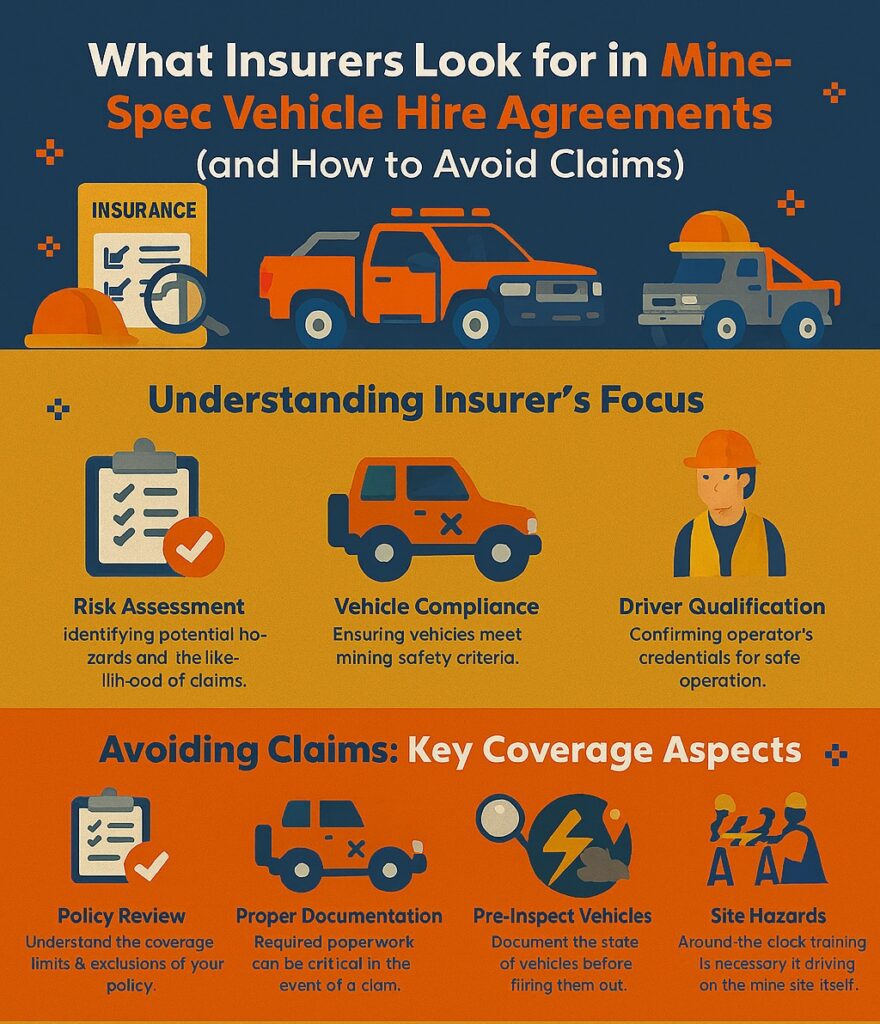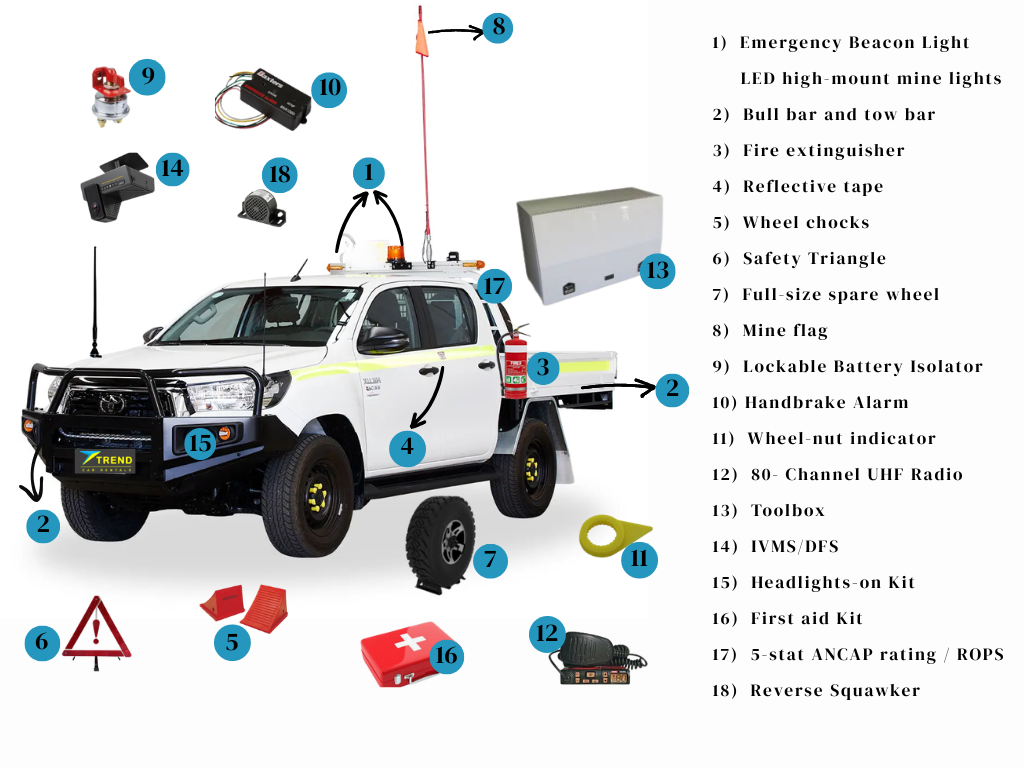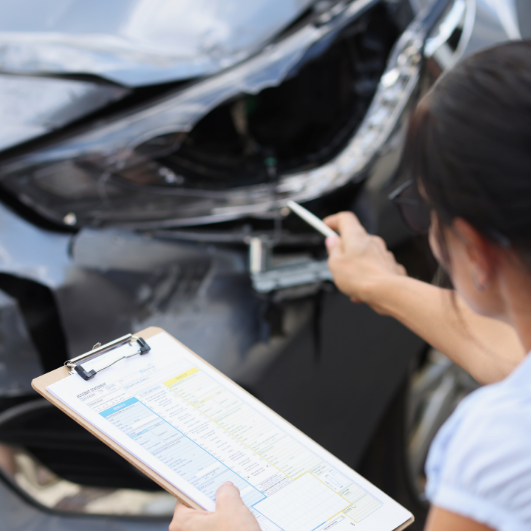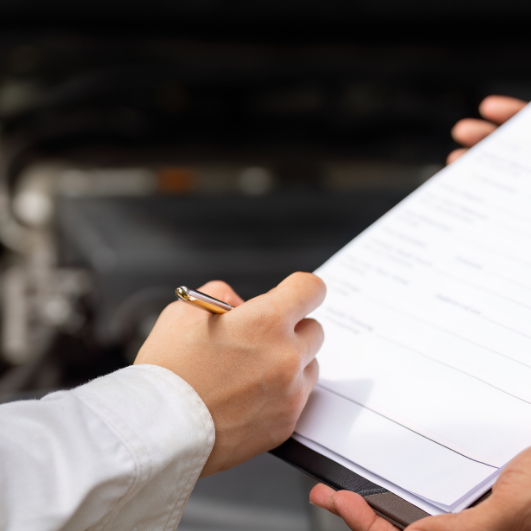Mining operations are among the most demanding industries in Australia, requiring vehicles that meet stringent safety, compliance, and operational standards. Mine-spec vehicles—customized to handle rugged terrain, hazardous conditions, and strict site protocols—are essential for accessing mining sites. But hiring these vehicles isn’t just about ticking boxes on a checklist. It’s also about understanding what insurers look for in hire agreements to avoid costly claims and ensure seamless coverage.
In this blog, we’ll explore the key elements insurers scrutinize in mine-spec vehicle hire agreements, offer actionable mine spec vehicle insurance tips, and show you how to avoid common pitfalls. We’ll also highlight how Trend Rentals can help you stay compliant and claim-free.

🚧 What Is a Mine-Spec Vehicle?
A mine-spec vehicle is a standard commercial vehicle—typically a ute, 4WD, or truck—modified to meet the safety and compliance requirements of mining sites. These modifications may include:
- Roll cages and bull bars
- High-visibility markings
- Fire extinguishers and first aid kits
- Battery isolators and two-way radios
- GPS tracking and reverse alarms
These features aren’t optional—they’re mandated by mining companies to protect workers and equipment in high-risk environments. Learn more about mine-spec requirements in Trend Rentals’ compliance guide.

🛡️ Why Insurers Care About Hire Agreements
Insurance providers assess risk before offering coverage. In the context of mine-spec vehicle hire, they evaluate:
- Compliance with safety standards
- Driver qualifications and training
- Vehicle maintenance records
- Site-specific hazards
- Contractual clarity and documentation
If any of these elements are missing or poorly defined, insurers may deny coverage or reject claims. That’s why crafting a robust hire agreement is critical—not just for legal protection, but for insurance peace of mind.

📋 What Insurers Look For in Hire Agreements
Let’s break down the key components insurers expect in a mine-spec vehicle hire agreement:
1. ✅ Vehicle Compliance Documentation
Insurers want proof that the vehicle meets mine-site specifications. This includes:
- A checklist of installed safety features
- Certification of compliance with site standards
- Records of recent inspections
Trend Rentals offers a detailed mine-spec vehicle checklist to help hirers verify compliance.

2. 👷 Driver Credentials
Operators must be qualified to drive on mining sites. Insurers typically require:
- Valid driver’s license (appropriate class)
- Site induction certificates
- Proof of experience in similar environments
Including these credentials in the hire agreement reduces liability and strengthens your insurance position.

3. 🧾 Clear Contract Terms
Ambiguity is the enemy of insurance. Your hire agreement should clearly define:
- Duration of hire
- Responsibilities for maintenance and damage
- Insurance coverage limits and exclusions
- Procedures for incident reporting
Trend Rentals simplifies this process with transparent contracts and support for fleet managers.

4. 🔍 Pre-Hire Inspection Reports
Insurers often request documentation of the vehicle’s condition before hire. This helps:
- Prevent disputes over pre-existing damage
- Establish a baseline for wear and tear
- Support claims if accidents occur
Include photos, checklists, and timestamps in your inspection report.

5. 🌦️ Site and Weather Risk Assessment
Mining sites are prone to extreme weather and terrain challenges. Insurers want to see:
- Risk mitigation strategies (e.g., weatherproofing, tire upgrades)
- Site-specific hazard analysis
- Emergency response protocols
These details show that you’ve considered environmental risks and taken steps to minimize them.

🚫 Common Mistakes That Lead to Claims
Even with the best intentions, oversights can lead to denied claims. Here are some common pitfalls:
- Missing compliance features (e.g., no fire extinguisher)
- Unqualified drivers operating vehicles
- Poor documentation of vehicle condition
- Ambiguous contract language
- Failure to report incidents promptly
Avoid these mistakes by following Trend Rentals’ expert mine-spec hiring tips.
💡 Mine Spec Vehicle Insurance Tips
To stay protected and avoid claims, follow these insurance best practices:
1. Review Your Policy Thoroughly
Understand what’s covered—and what’s not. Look for:
- Coverage limits
- Exclusions (e.g., off-road damage)
- Requirements for documentation
2. Communicate with Your Insurer
Before hiring, notify your insurer and share:
- Vehicle specs
- Site details
- Driver credentials
This proactive approach builds trust and ensures coverage aligns with your needs.
3. Keep Maintenance Records
Regular servicing and inspections reduce risk. Maintain logs of:
- Oil changes
- Brake checks
- Tire replacements
- Safety feature tests
Trend Rentals provides maintenance support to keep your fleet in top shape.
4. Train Your Team
Driver training is essential. Offer:
- Site inductions
- Defensive driving courses
- Emergency response drills
Insurers reward businesses that invest in safety.
5. Document Everything
From hire agreements to incident reports, keep detailed records. Use:
- Digital logs
- Timestamped photos
- Signed checklists
This documentation is your strongest defense in the event of a claim.
🔄 How Trend Rentals Helps You Stay Compliant
Trend Rentals is a trusted provider of mine-spec vehicles across Australia. Here’s how they support insurance-friendly hire agreements:
- Fully compliant vehicles with all required safety features
- Transparent contracts that meet insurer standards
- Pre-hire inspections and documentation
- Driver support and training
- Maintenance tracking and servicing
Explore their full range of services at trendrentals.com.au and check out their blog for more mine-spec compliance insights.
🏁 Final Thoughts
Mine-spec vehicle hire is more than a logistical task—it’s a legal and insurance-critical process. By understanding what insurers look for, crafting airtight hire agreements, and partnering with experienced providers like Trend Rentals, you can avoid costly claims and keep your operations running smoothly.
Remember: compliance isn’t just about safety—it’s about protecting your business, your people, and your bottom line.